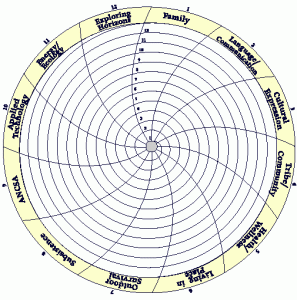Raven Tales
Over the past month colleagues and I have engaged in dynamic asynchronous conversations over the pros and cons of Indigenous peoples using technology as a resource to transfer and preserve culture. As with most meaningful dialogues, passionate discussion was given on both sides of the issue. One of my grounding rationales for seeing technology as a positive resource for Indigenous peoples is how First Nations students in my classroom utilize technology. My students’ (whether First Nations or non-First Nations) engagement with technology is by and large unified across culture and gender. Though, when students are also able to integrate culture with the technology being utilized both interest and acquisition of learning outcomes is enhanced.
As an example, coinciding with a guided reading unit on First Nations legends I have used the Raven Tales series. It was a wonderful experience having two First Nations students in my group making connections to stories their grandparents had told them as well as an added reinforcement of the morals and values being viewed in the series. Through the engaging CGI graphics of the Raven Tales episodes both First Nations and non-First Nations students were actively engaged in making connections, inferencing, and synthesizing the ideas we were being introduce to within the legends we were reading.
Alaska Native Knowledge Network
The Alaska Native Knowledge Network (ANKN) offers a wide range of information and resources for individuals and groups interested in traditional Alaska Native knowledge systems and ways of knowing (ANKN, 2008). The ANKN is a meta-site providing publications, Alaska Native newsletter, curricular resources, and an extensive site index.
Of particular note, are the side navigation links to: Native Pathways to Education, Alaska Native Cultural Resources, Indigenous Knowledge Systems, and Indigenous Education WorldWide (ANKN, 2008). As my analytic paper is looking into the use of information communication technologies (ICT) for an inclusive culturally based education system in British Columbia I was delighted to read the following off of ANKN’s curriculum link, “Indigenous and Western knowledge systems can be brought to bear in schools through a balanced, comprehensive and culturally-aligned curriculum framework adaptable to local circumstances” (AKNK, 2008). I am still working my way through this site though I am very pleased with the information and resources I have investigated to date.
ANKN Curriculum Spiral Chart
Please click on the TKRP image to go to the website.
The Traditional Knowledge Revival Pathways website (TKRP) is a site dedicated to the preservation and transmission of traditional knowledge that supports “Indigenous Elders to mentor the process of Indigenous Knowledge Research and recording throughout Australia and with interests Inter-nationally” (TKRP, 2008).
One of the main goals of this project is to ensure cultural knowledge is preserved and to demonstrate the ability of traditional knowledge in enhancing or supplanting modern methodologies for dealing with community and environmental issues. Use of information communication technologies (ICT) such as digital technology is use extensively as a means to preserve and transmit traditional Indigenous knowledge.
[youtube]https://www.youtube.com/watch?v=wvEcjmTwH_0[/youtube]
Of particular interest are the links to specific Indigenous communities (Aurukun, Djungun, Kuku-Thaypan, Buru, Shipton Flats, Kalpowar, and Moriori) that have successfully used TKRP initiatives to help preserve Indigenous culture. Each of these communities initiated programs that have integrated traditional knowledge with educational and environmental practices. “Today, the people still speak their traditional language which has been preserved through maintaining a cultural lifestyle and connection to their homelands. Through the work of the team in Aurukun and assistance of TKRP, the community has developed outcomes that support the application of Traditional Knowledge for education by using new aged technology” (TKRP, 2008).
Please click on the CWIS banner to go to their website.
The Centre for World Indigenous Studies (CWIS) acts as a forum where indigenous and non-indigenous peoples can access literature and research that relates to Fourth World Nations. Founded by Dr. Rudolph C. Ryser, Ph.D. and Chief George Manuel CWIS brings together resources which help promote “ideas for solving social, economic and political problems in the Fourth World” (CWIS, 2008). Links to further CWIS resources are provided through following its sub-heading links; namely, programs, resources, and information.
I discovered many interesting articles and links on this website. As an educator who lives and works on Vancouver Island and is currently working on an analytic paper looking into Culturally Based Education (CBE), Dr. Ryser’s audio clip “Oolichan Oil: Elixir of the Sea“ and video clip “Canoe Journeys of Pacific Northwest Indian Nations“ were some of the more enlightening and engaging resources I discovered. Dr. Ryser`s clips demonstrate the interconnectedness of traditional cultural resources with health and wellbeing of both indigenous and non-indigenous peoples. I believe it is also important to note the use of information communication technologies (ICT) employed to transmit Dr. Ryser`s messages to a broader audience.
Please click on the Australian Flexible Learning Framework banner to go to their website.
I was immediately drawn to the concept of using infotainment as a teaching methodology as utilized by Interactive Ochre`s learning framework. In my own teaching practice I see the engagement of students within my class whenever I can integrate curricular outcomes, technology, and entertainment e.g., using a SMART board to play jeopardy.
As described in the summary of Interactive Ochre, the medium enables Aboriginal Australians to not only “tell their stories“ but to work successfully through sensitive issues that might not be possible otherwise.
http://toolboxes.flexiblelearning.net.au/demosites/series9/907_demo/907/swf/index.htm




